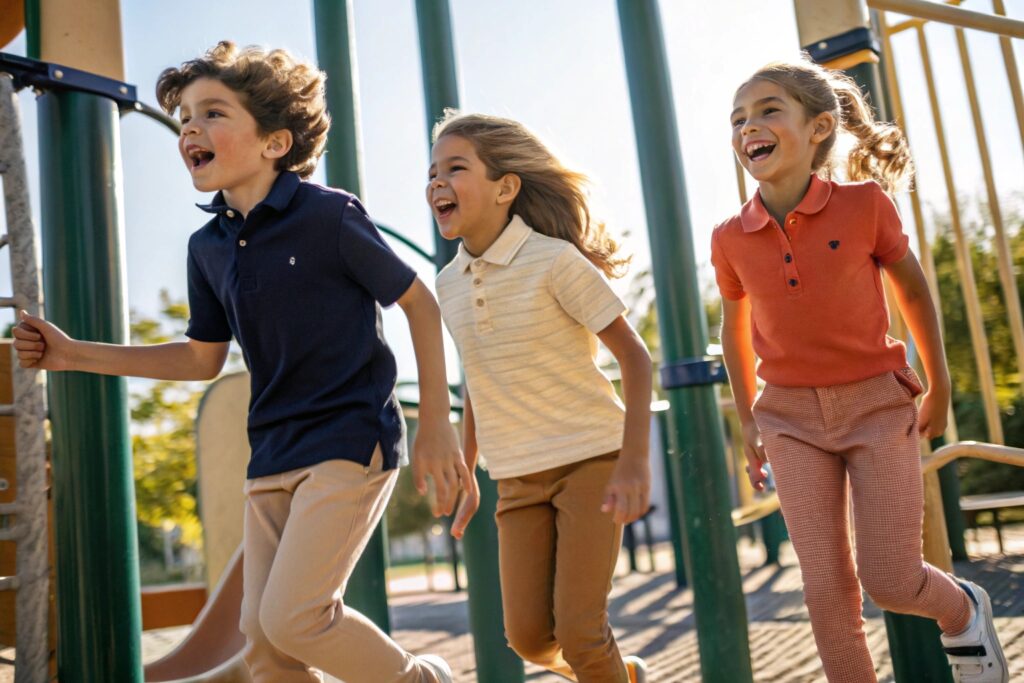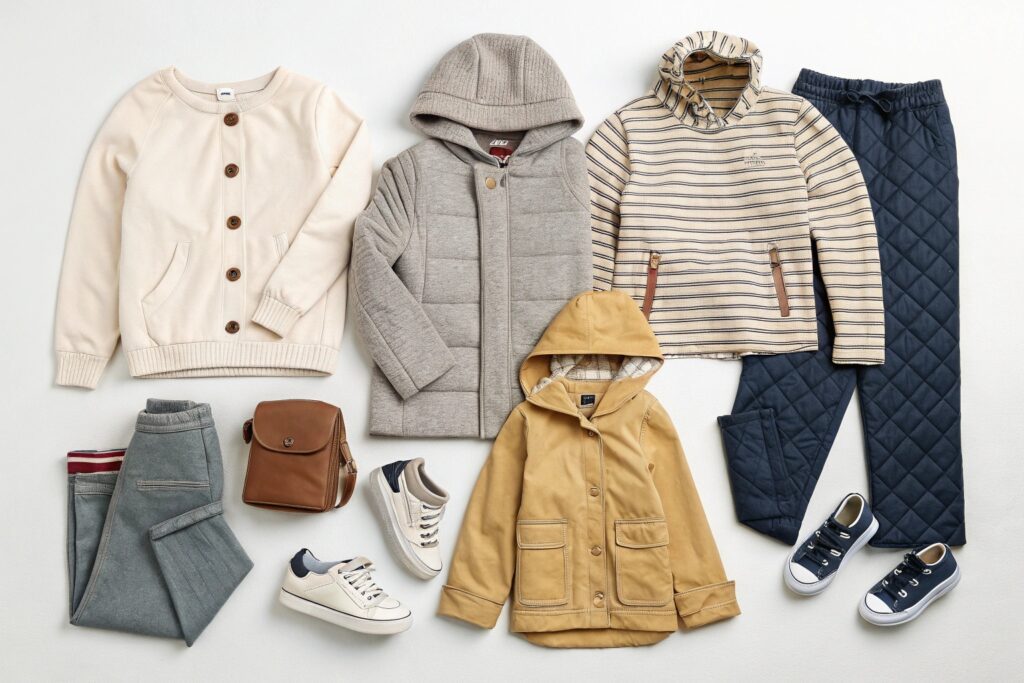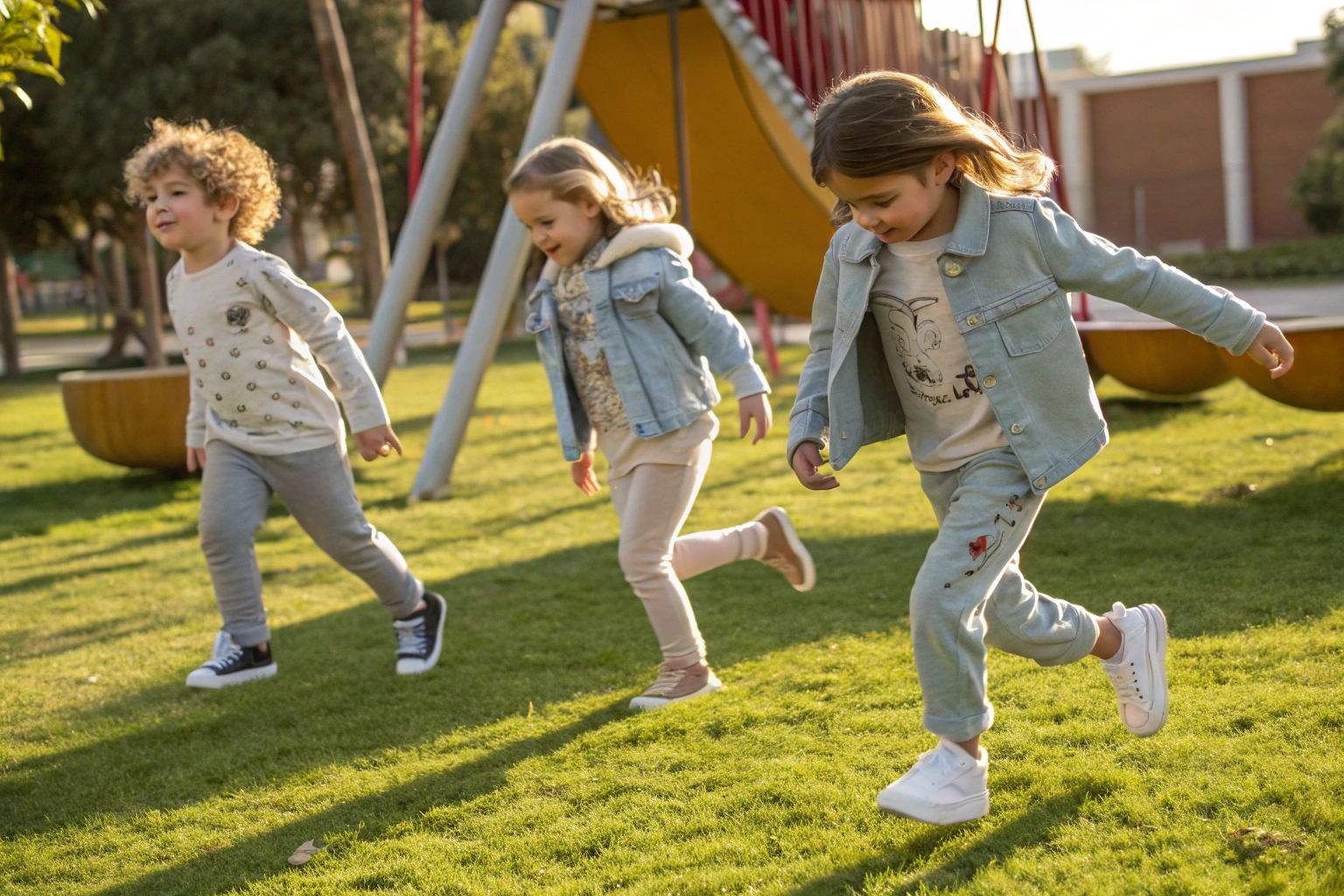Parents and buyers know how hard it is to balance cute styles with durable, everyday wear for children. Many brands promise both, but few deliver consistently.
Yes, it’s possible to create kids’ capsule wardrobes that look great and still stand up to all the jumping, rolling, and spills kids put their clothes through.
This article shares the exact fabrics, key seasonal strategies, trend insights, and essential pieces that help combine function and fashion in kids’ capsules. These insights are based on my years in the garment manufacturing business, working with buyers who demand both quality and style.
Best Fabrics for Stylish and Functional Kidswear?
Every parent wants their child to look good—but what if the clothes can’t handle the playground? That’s the tension every buyer and brand faces.
The best fabrics for kids’ capsule wardrobes are those that offer durability, breathability, and easy maintenance—without compromising style.

What Are the Most Durable Yet Comfortable Fabrics for Children’s Daily Clothing Needs?
From daily recess to weekend trips, children need clothes that breathe, bend, and bounce back. Natural fibers like cotton remain a top choice, but blends are gaining popularity. Cotton-spandex blends, for example, add stretch without losing softness. For high-activity pieces like joggers or leggings, interlock or rib-knit fabrics provide stretch and structure. Denim with spandex also gives a modern look with playground functionality.
We work with buyers who specify fabric weights. For kids, 180-220 GSM (grams per square meter) is the sweet spot—light enough for comfort, but thick enough for wear. These small specs make a big difference.
Some of our clients in North America and Europe now also request organic cotton or OEKO-TEX certified materials. Not just for the "green" angle—these fabrics are often more breathable and skin-friendly.
Which Fabrics Maintain Their Look After Repeated Washing and Wear?
Shrinkage and pilling are major issues in kidswear. Polyester blends offer wrinkle resistance and longevity. But too much polyester, and the garment feels plasticky. We balance this with modal or bamboo viscose for softness.
Here’s a breakdown of high-performing fabrics:
| Fabric Type | Key Benefit | Best Use Case |
|---|---|---|
| Cotton-Spandex | Soft, stretchy | T-shirts, leggings |
| Cotton-Poly Blend | Less shrinking, durable | Tees, dresses |
| Interlock Knit | Strong with elasticity | Joggers, rompers |
| Bamboo Viscose | Breathable, soft | Underwear, base layers |
| Denim + Elastane | Tough with flex | Jeans, jackets |
We’ve helped brands blend materials to get that ideal combo of washability, look, and feel—something our factory specializes in.
How to Build a Seasonal Capsule Wardrobe for Kids?
Do you ever open your child’s closet and realize half the clothes no longer fit or match? That’s what a poor capsule looks like.
A seasonal kids’ capsule wardrobe should include mix-and-match pieces that cover changing weather, growth spurts, and multiple occasions.

What’s the Ideal Number of Items for a Kids’ Capsule Per Season?
Most families don’t need 50 pieces. Capsule wardrobes typically work best with 15–25 items per season. For spring and fall, that might mean:
- 5 tops (2 long sleeve, 3 short sleeve)
- 3 bottoms (2 pants, 1 shorts/skirt)
- 2 layering pieces (cardigan or hoodie)
- 1-2 special items (occasion dress or button-up)
- 2 sets of PJs
- 1 outerwear piece
- 3–5 accessories (hats, socks, etc.)
Capsules should reflect your climate. In warmer states, you may need lighter base layers; in northern areas, thicker fleece or Sherpa-lined coats.
We often assist our buyers by setting up seasonal lookbooks so they can build pre-packs based on these core categories. It helps them sell smarter and stock more efficiently.
How Can You Adjust Kids’ Capsules to Handle Growth Spurts and Weather Swings?
Kids grow fast—some seemingly overnight. That’s why smart capsule wardrobes need built-in flexibility.
Here are three tips we use when planning capsule designs with clients:
- Adjustable Waistbands: These extend a pant’s lifecycle by months.
- Stretch Fabrics: Leggings with 5–7% spandex accommodate growth.
- Layer-Friendly Cuts: Loose-fit tees or tunics can later become base layers.
We recommend planning two capsules a year: one for warmer weather and one for cold. We also advise keeping color palettes neutral with a few pops—so pieces across seasons can layer up or down.
Top Trends in Practical Yet Fashionable Kids Clothing?
Fashion moves fast—even for kidswear. But not every trend is worth chasing when clothes need to survive the sandbox.
Current kidswear trends focus on earthy tones, gender-neutral styling, and playful graphics—but with practical features like stretch, washability, and quick dressing built in.

What Are the Most Sought-After Design Features in Today’s Kidswear Market?
Based on our sourcing data and client feedback from trade shows, the most requested features in 2025 include:
- Drop shoulders and boxy cuts: More comfortable and trendy
- Neutral earthy tones: Easy to mix and match
- Elastic cuffs and necklines: Makes dressing easier for younger kids
- Double-knee pants: More durable for toddlers
- Hidden labels or printed care info: Reduces skin irritation
Fashion-forward doesn’t mean impractical. One of our U.S. clients custom-ordered pieces in muted clay tones and added big front pockets. Kids loved them for storing treasures—parents loved them for being easy to match and wash.
How Do Big Retailers Stay on Trend While Managing Production Risks?
Many major kidswear buyers place orders months ahead, and guessing the wrong trend can be expensive. That’s where capsules help.
Capsule-focused trends (like color-coordinated sets or seasonless silhouettes) reduce risk. Retailers can rotate 2–3 new “highlight” pieces each season, while keeping the rest of the line steady. That’s something we help plan by providing style simulations with our CAD support and trend forecasts.
We also offer low-MOQ options for trend-testing SKUs, letting brands avoid overstock. Practicality doesn’t have to kill creativity.
Essential Pieces for a Minimalist Kids Capsule Wardrobe?
Many buyers struggle with overdesigning their kids’ collections. But simplicity actually boosts sales—because parents value versatility.
The core pieces of a minimalist kids’ capsule should all serve more than one purpose, pair with multiple items, and be easy to layer.

What Are the Must-Have Items That Form the Backbone of a Kid’s Wardrobe?
Capsules work best when every item earns its place. Here’s our basic framework, used by brands and distributors sourcing through us:
| Category | Item | Purpose |
|---|---|---|
| Tops | Neutral long-sleeve tee | Base layer and everyday wear |
| Tops | Graphic short-sleeve tee | Fun + casual looks |
| Bottoms | Jogger or sweatpants | Comfort and movement |
| Bottoms | Denim pants or shorts | Durable and versatile |
| Layers | Zip-up hoodie | Easy-on, works year-round |
| Outerwear | Lightweight jacket | Transitional and travel-friendly |
| Sleepwear | Breathable PJ set | Nighttime comfort |
| Occasion | Button-up or dress | For events or school pictures |
That’s a full set under 20 items. All of them can mix, layer, and match across seasons.
How Can Brands Communicate Simplicity and Versatility to Parents?
Parents get overwhelmed. Too many choices backfire. Smart brands now market these minimalist capsules as “grab-and-go” or “mix-and-match ready.” We’ve helped several clients build storytelling around simplicity:
- “10 pieces, 30 outfits” campaigns
- Print or tag color coordination guides
- Seasonal packing lists for school or vacations
By bundling outfits or showcasing lookbooks, brands can drive higher AOV (average order value) while still promoting thoughtful shopping.
And for sourcing—factories like ours streamline it. We work in DDP mode, offer customizable sets, and guarantee consistent sizing and QC across shipments.
Conclusion
Function and fashion don’t need to compete in kids’ capsules. With the right fabrics, smart planning, and trend-conscious design, you can create collections that perform and sell. If you’re looking for a partner to bring your ideas to life—Fumao Clothing is ready.










